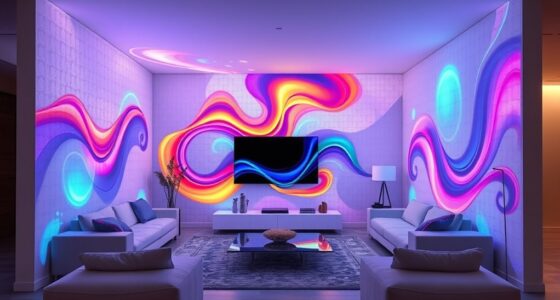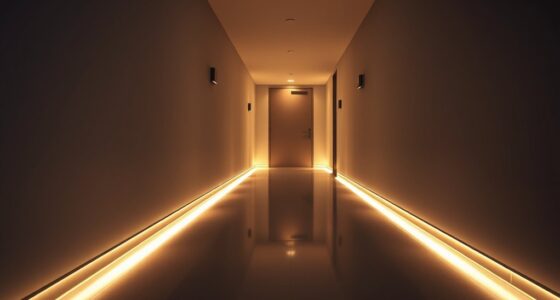Choose a smart dimmer when you want to control fixed fixtures, set moods, and save energy by adjusting brightness at the switch level. Opt for smart bulbs if you want versatile, color-changing lighting that’s easy to install and move around. Both help personalize your home, but each shines in different situations. Want to discover which option suits your lifestyle best? Keep exploring to find out more.
Key Takeaways
- Use smart dimmers for controlling fixed fixtures and creating customizable lighting moods in a room.
- Choose smart bulbs for versatile, colorful lighting options and easy installation in various fixtures.
- Opt for dimmers to save energy in rooms with constant lighting needs and when adjusting brightness is essential.
- Use smart bulbs for quick upgrades, especially when you want dynamic color changes or remote control without wiring changes.
- Select dimmers for ambiance control in fixed lighting setups and bulbs for flexible, decorative, or temporary lighting needs.

When it comes to controlling your home’s lighting, choosing between a smart dimmer and a smart bulb depends on your needs and preferences. Both options offer unique advantages, but understanding how each impacts lighting ambiance and energy efficiency can help you make the right choice. Smart dimmers give you the ability to adjust the brightness of existing light fixtures, allowing you to create the perfect mood for any occasion. Whether you want a cozy, dim glow for movie night or bright light for reading, a smart dimmer provides seamless control over your lighting ambiance. Plus, because you’re controlling the power delivered to the bulbs, you can reduce energy consumption by dimming lights when full brightness isn’t necessary. This makes smart dimmers an excellent choice for energy efficiency, especially if you want to cut down on electricity bills or promote eco-friendliness.
On the other hand, smart bulbs come with their own set of benefits. They are easy to install—simply replace your existing bulbs—and often come with features like color changing and scheduling. If you crave versatility in lighting ambiance, smart bulbs are ideal because they can produce a wide spectrum of colors and intensities. This allows you to personalize your space with vibrant hues or soft whites, adjusting the atmosphere to match your mood or activity. Additionally, smart bulbs are more flexible in terms of placement. You can use different styles and sizes in various fixtures without needing to replace switches or install additional hardware. When it comes to energy efficiency, many smart bulbs are designed to consume less power than traditional incandescent bulbs, and with features like scheduling and remote control, you can ensure lights aren’t left on unnecessarily, further saving energy. Understanding the Aloe Vera Plant Problems can help you maintain healthy lighting environments that support plant growth and overall home wellness.
Frequently Asked Questions
Can Smart Bulbs Work Without a Dimmer Switch?
Yes, smart bulbs can work without a dimmer switch. They usually have built-in dimming features and are compatible with standard switches, but their dimming compatibility depends on the bulb type. You won’t need a special dimmer switch, making installation easier. Keep in mind that some smart bulbs might not dim smoothly or at all if your existing switch isn’t compatible, so check the bulb’s specifications before purchasing.
Are Smart Dimmers Compatible With All Types of Bulbs?
Smart dimmers are not compatible with all types of bulbs; their compatibility depends on the bulb type and bulb compatibility. You need to check if your bulbs are dimmable and compatible with specific dimmer types, such as leading-edge or trailing-edge dimmers. Some LED or CFL bulbs may require special dimmers, so always verify the manufacturer’s recommendations to guarantee seamless operation and avoid flickering or damage.
How Does Installation Differ Between Smart Dimmers and Smart Bulbs?
When installing smart dimmers versus smart bulbs, you’ll notice wiring complexities with dimmers since they connect directly to your home’s wiring and may require additional installation tools. Smart bulbs are easier—you just screw them into existing sockets. For dimmers, you might need to turn off power, strip wires, and use screwdrivers, making the process more involved. Smart bulbs typically require minimal tools and effort, perfect for quick upgrades.
Do Smart Dimmers Require Wi-Fi or Internet Connection?
Think of smart dimmers as the silent maestros of your lighting orchestra. They don’t require Wi-Fi or internet dependency to work, relying instead on wireless connectivity through your home’s wiring. This means you can control your lights even if the internet’s down. So, no, smart dimmers don’t need Wi-Fi or internet to operate, giving you reliable, seamless control whenever you want it, regardless of connectivity issues.
Can I Control Smart Bulbs and Dimmers With the Same App?
Yes, you can control smart bulbs and dimmers with the same app, making lighting automation seamless. Many smart home apps support both device types, allowing you to adjust brightness, set schedules, and even use voice control compatibility. Just make certain your devices are compatible with the app you’re using, and you’ll enjoy centralized control for all your lighting needs, whether dimming or turning lights on and off.
Conclusion
Choosing between a smart dimmer and a smart bulb depends on your needs, like selecting the right tool for a job. Think of a smart dimmer as a versatile artist’s palette, offering control over brightness and ambiance, while a smart bulb is like a ready-to-use brush, providing instant smart lighting. By understanding their differences, you can create a cozy, customized space that feels just right—like a perfectly tuned instrument in your home’s symphony.









